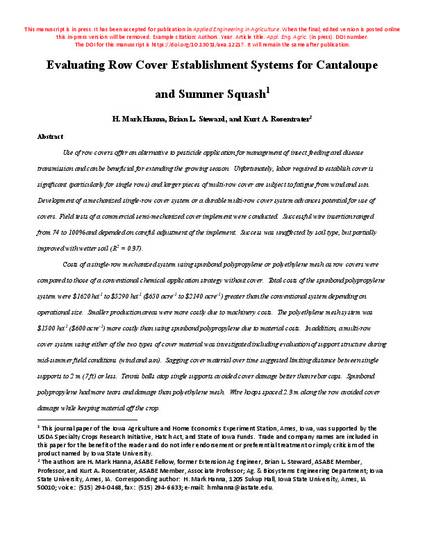
Use of row covers offer an alternative to pesticide application for management of insect feeding and disease transmission and can be beneficial for extending the growing season. Unfortunately, labor required to establish cover is significant (particularly for single rows) and larger pieces of multi-row cover are subject to fatigue from wind and sun. Development of a mechanized single-row cover system or a durable multi-row cover system advances potential for use of covers. Field tests of a commercial semi-mechanized cover implement were conducted. Successful wire insertion ranged from 74 to 100% and depended on careful adjustment of the implement. Success was unaffected by soil type, but partially improved with wetter soil (R2 = 0.37). Costs of a single-row mechanized system using spunbond polypropylene or polyethylene mesh as row covers were compared to those of a conventional chemical application strategy without cover. Total costs of the spunbond polypropylene system were $1620 ha-1 to $5290 ha-1 ($650 acre-1 to $2140 acre-1) greater than the conventional system depending on operational size. Smaller production areas were more costly due to machinery costs. The polyethylene mesh system was $1500 ha-1 ($600 acre-1) more costly than using spunbond polypropylene due to material costs. In addition, a multi-row cover system using either of the two types of cover material was investigated including evaluation of support structure during mid-summer field conditions (wind and sun). Sagging cover material over time suggested limiting distance between single supports to 2 m (7 ft) or less. Tennis balls atop single supports avoided cover damage better than rebar caps. Spunbond polypropylene had more tears and damage than polyethylene mesh. Wire hoops spaced 2.3 m along the row avoided cover damage while keeping material off the crop.
Available at: http://works.bepress.com/mark_hanna/216/

This is a manuscript of the article Hanna, H. Mark, Brian L. Steward, and Kurt A. Rosentrater. "Evaluating Row Cover Establishment Systems for Cantaloupe and Summer Squash." Applied Engineering in Agriculture (2018). DOI: 10.13031/aea.12217. Posted with permission.